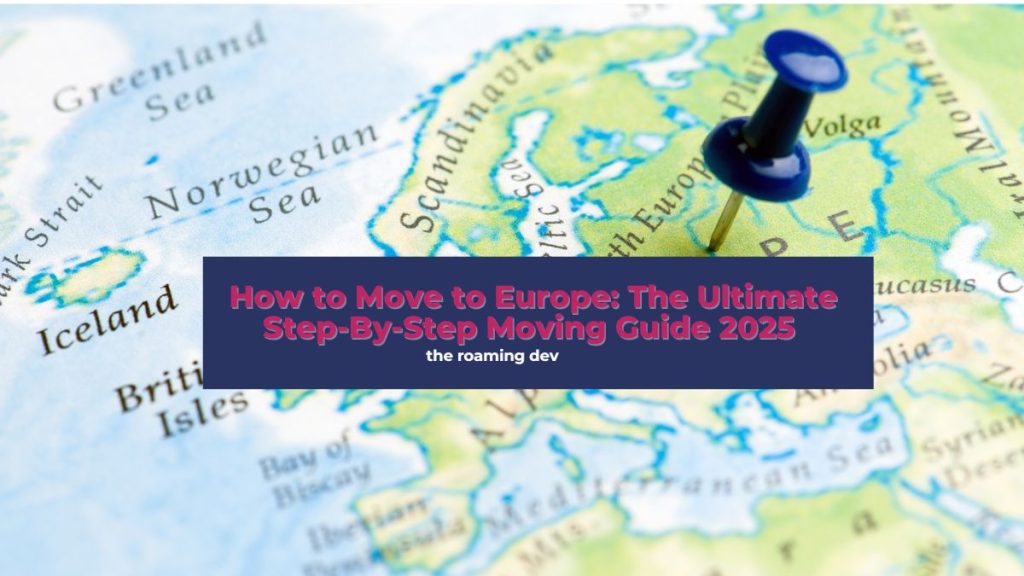How to Move to Europe: The Ultimate Step-By-Step Moving Guide 2025. One of the things that have been surging in the recent past is wanderlust.
So many people in the US and other countries are seeking foreign visas and second passports. Most of them are looking to move to Europe.
This could have been triggered by the introduction of friendly visas and residency permits by several European countries.
Initially, many non-EU citizens could not move to Europe with ease due to visa restrictions.
But now that several European countries have made their visas and residency permits open and flexible to more people, there is no reason why you shouldn’t consider moving to Europe.
But before you start packing your things and making that move, you have to figure out a lot of things, such as identifying the right visa option and scouting for that perfect new place to relocate to.
The good thing is that moving to Europe doesn’t have to be overwhelming.
In this guide on how to move to Europe, we will explore the steps that you need to follow to make the transition as smooth as possible.
We will also look at some of the best destinations to move to as well as visa requirements.
Reasons to Move to Europe
There are so many reasons why many people, especially Americans, would love to move to Europe.
The European continent offers an array of benefits ranging from the impressive lush landscapes and architecture to the high quality of life.
Here are the real benefits of relocating to Europe:
1. Affordable Housing Options
One of the things that makes Europe attractive to most people is the quality and cost of housing available.
The continent offers lots of affordable housing options, ranging from shared apartments in bigger cities to quiet semi-private residences in small towns.
So, you can choose the type of housing that suits your preferences and budget.
2. Safety and Social Support Network
Safety is an important factor when considering a destination to visit.
The good thing is that most countries in Europe are considered safe.
In fact, most EU countries rank high on the global peace and safety index.
3. Diverse Educational Opportunities
Besides the US, Europe is recognized for its world-class universities and other educational institutions.
The good thing about European education is that it is more affordable when compared to the US.
Most courses are also offered in English. So, it can be an ideal place if you are looking to upgrade your skills without accumulating unnecessary debt.
4. Cultural Diversity and Historical Richness
Unlike some regions of the world, Europe is culturally diverse, making it attractive to many people.
There is always something to learn about the cultures of different people in Europe.
Each place you will visit will likely have a unique culture and heritage.
5. Quality and Inclusive Healthcare System
Europe is respected for its sound and equitable healthcare system.
Most people loved the system because it is inclusive and accessible to all legal residents, even if you are there temporarily.
How to Move to Europe: Visa Options
One of the things that may prevent many people from moving to Europe is the restrictive visa regime.
To legally reside in a European country, you need a work permit or foreign residency visa. So, you have to apply for the visa while still in your home country.
The good thing is that many European countries have introduced attractive short-term visas and investment programs that guarantee permanent residency.
So if you are an investor, digital nomad, student, a retiree, or have some in-demand skills, the path to Europe is now easier than ever.
One of the most interesting things about how to move to Europe is that some countries have a more straightforward option for residency.
With that said, here are some of the popular visa options for living in Europe:
- Work visa
- Student visa
- Investment visa
- Retirement visa
- Self-employment visa
- Digital nomad visa
- Business/entrepreneur visa
- Citizenship by descent
- Spousal/partner visa
Once you obtain one of the above visas, you also need to apply for permanent residency.
To do so, you need to submit the application in person at the local immigration office or consulate and provide the necessary documents.
These may include:
- Visa application form
- Valid passport
- passport-sized photos
- Health insurance coverage
- Proof of accommodation
- Proof of sufficient funds
- Clean criminal record report
- Job offer or employment contract, especially if you are applying for a work permit.
Step-by-Step Process on How to Move to Europe
While there are several benefits associated with relocating to Europe, the process might be a bit complex, especially if you are doing so for the first time.
But if you follow this step-by-step guide, the process will be hassle-free:
Step One: Research Your Dream Destination
Before you plan your move to Europe, you need to choose potential destinations.
As you know, Europe is a vast continent with 44 countries, with each offering unique experiences and advantages.
So, as you research for your ideal destination, consider things like job opportunities, cost of living, cultural offers, beauty, safety, and climate.
Step Two: Understanding Immigration Policies
Part of preparation for how to move to Europe is navigating immigration policies. If you have relocated abroad before, you will appreciate the need to understand immigration policies.
So, once you have identified the ideal country(s) you want to move to, the next step is to understand the rules and regulations regarding visas and residency permits for the chosen countries.
This is only applicable for non-EU citizens. The good thing is that government websites usually have a lot of information on this subject.
Step Three: Apply for Visa and Residence Permits
Once you have gathered enough information about immigration policies and visa types, you can now start applying for visas and resident permits.
Depending on the country you are moving to and your nationality, you may need specific requirements for the visa and residency permits.
So, prepare these things in advance and submit your application.
List of European Digital Visa:
- Portugal Golden Visa. The Complete Guide For 2024
- The 7 Best Digital Nomad Visas in Europe
- Greek Digital Nomad Visa. The Complete Guide For 2024
- Estonia Digital Nomad Visa: The Complete Guide for 2024
- Digital Nomad Visa Spain: Everything You Need To Know
Step Four: Handle the Finances
It is also important to create a detailed budget that will cover all expenses associated with your move to Europe.
So, you can create a budget that includes travel insurance, logistical expenses, accommodations, daily living costs, and emergency funds.
Preparing a budget also involves saving money to cover for the move. Having enough funds to sustain you while exploring new opportunities and setting abroad will make the transition easier.
Step Five: Learn the Local Language
A majority of the European population speaks English, but it will help a lot to learn the basics of the local language and customs. Doing this will help you integrate with the locals faster and navigate daily life.
So, consider enrolling in online or physical classes to learn the new language. You can also use language learning apps to sharpen your skills.
Step Six: Build Connections and Find Community Abroad
Part of transitioning abroad involves connecting with people, be they local or expat communities. The easiest connection to build while still in your home country is an expat community.
Try looking for relevant expat communities in the country you wish to move to in Europe.
Thankfully, platforms like Meetup allow you to connect with expats who have the same interests and ambitions as you.
These communities are mainly found in major cities across Europe. You can also link up with them online.
Step Seven: Dip Your Toes Before Taking the Plunge
Some people prefer to test the waters before making the full relocation.
So, you may want to make a short visit to the country you want to move into and experience local culture and landscape before full commitment.
Step Eight: Organize the Logistics
Once you have the relevant documents and have saved enough money, you can then start organizing logistics around your move.
In this case, you may want to dispose of some of the items you have or even ship them to your new destination.
It also involves settling or canceling subscriptions or utilities in your home country. Basically, it involves tying the loose ends while still in your home country.
Step Nine: Prepare the Transition
The final step on how to move to Europe is to prepare for the transition.
There is no standard way of doing this, but much of it involves adjusting your mindset and embracing new cultures and opportunities offered by your new destination.
It also involves making the final move of actually relocating to the new country in Europe.
How to Move to Europe: Best Countries to Live In
As stated earlier, there are more than 40 countries in Europe, the majority of which belong to the European Union.
Each of these countries has its own unique features, but some are more attractive than others when you take into account all factors.
With this in mind, here are some of the best European countries to relocate to:
- Germany: Being the largest economy in Europe, Germany is one of the most attractive places to move to. It is usually attractive to those looking for career opportunities because the country has a thriving job market, especially for IT professionals, engineers, and health professionals.
- Portugal: Portugal is a haven for digital nomads. With its sunny climate, affordable cost of living, stable internet connectivity, and friendly locals, the country is a hotspot for digital nomads and expats alike.
- Spain: Spain’s cultural richness, beautiful landscapes, and affordable cost of living have made Spain attractive to many foreigners. Digital nomad visas and working holiday visas have made it easier for young adventures to explore the country.
- The Netherlands: The Netherlands might be one of the smallest countries in Europe, but the country boasts a strong economy, vibrant culture, and a tolerant society. The country is home to some of the most respected brands, such as Unilever, Shell, and Philips. So, the economy is always in need of skilled labor in various fields such as agriculture, engineering, IT, and finance.
- United Kingdom: The United Kingdom has historical ties with the US and other English-speaking countries. So, visitors will have an easy time adapting to the local culture and language. The country also enjoys a dynamic economy, diverse culture, and a global presence. There are so many expats in the UK, making the relocation and connection much easier.
Besides choosing the best countries, you may also want to consider countries with the friendliest immigration policies. Some of the easiest visas to obtain are the digital nomad visas.
Countries such as Georgia, Estonia, and Croatia have made it easier to relocate as a digital nomad. This is also the case with Spain, Portugal, and Italy.
Final Thoughts
Europe is attractive to many people around the world because of their cultural richness and diversity, affordable cost of living, quality education and healthcare systems, and stable economies.
The only issue is how to get there. One of the most challenging things about moving to Europe is obtaining a visa.
But with relevant information about how to move to Europe at your fingertips and early preparation, the dream of a move to Europe will be much more alive.
The good thing is that once you get a visa, you can roam in more than 20 countries visa-free.
Also Read:



